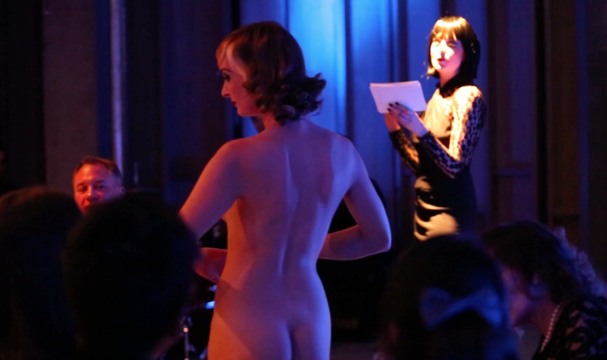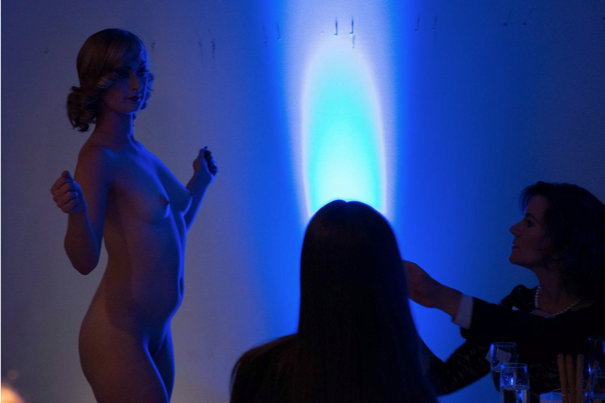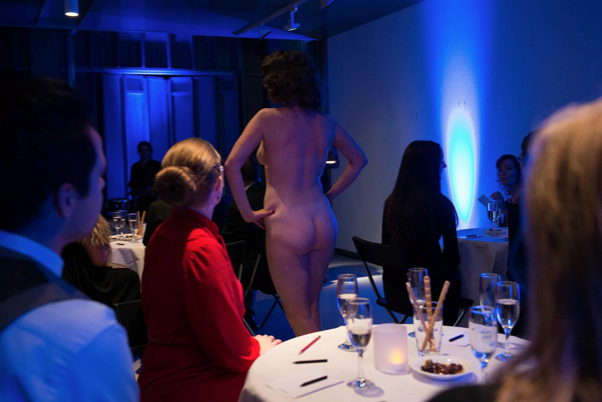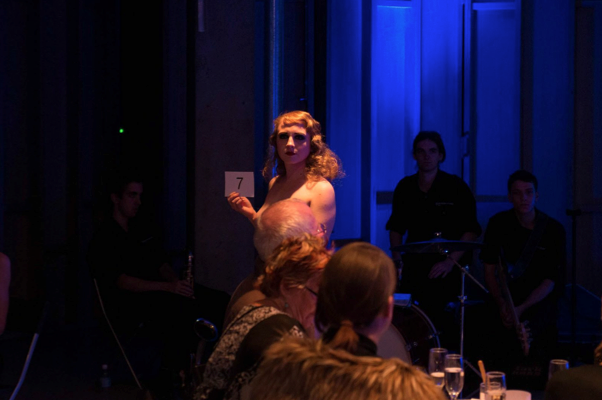PERFORMANCE IS SOMETHING INTEGRAL to fashion, in the industry, and in our everyday experience: from catwalk presentations, photo shoots and red carpet events to the dressing up we engage with in our daily lives, all are very much acts of performance in an industry that is necessarily expressive. Artist Adele Varcoe’s work is concerned with these functions – a keen observer of the phenomenon of fashion and our responsive behaviour, her performance events and happenings aim to address fashion and our experience of clothing. Varcoe is still working out what to put on her business card, but her research – she is currently completing her PhD at RMIT University in Melbourne – and her fashion practice, she has created performance events from the streets of London and Australia’s National Gallery of Victoria, to the remote Raghurajpur Village in India, that address these themes. In a recent work, ‘Imagining Chanel’ for MUMA at Melbourne’s Monash University, Varcoe created a salon-style fashion show of Chanel garments from the collection of the National Gallery of Victoria, only without the clothes. The Chanel garments, in their absence, were of course integral to the piece. Echoing semiotician Roland Barthes’ notion that fashion is more than a physical object, in Varcoe’s work fashion is a description, an image, a smell, a notion, an opinion.
Laura: How would you describe your practice, or, to be more specific, what is your job title?
Adele: I have been described as a fashion activist, an agent, a fashion psychologist, a protagonist. I’m interested in how clothing can affect the relations and interactions between people – and how they bring out the characters we play in everyday life.
Laura: It’s funny because I always identified your work more as a performance art practice, but within a fashion context. But I wonder if you align with fashion or with art, or do you see yourself as somewhere in between? How do you position yourself between these worlds?
Adele: Recently I have been presenting work in museum or gallery contexts that could be tied to a fashion festival or contemporary art events. The ideas come from fashion, dress and clothes, but are executed through participatory situations and I think this is how the projects can slip between the two. I’m interested in how the people around us affect the way we feel in what we wear and if we dress for others rather than for ourselves. In some ways the situations are a material investigation into people, fashion and the psychological or sociological processes at play. These situations I create aim to give the participant a ‘aha’ moment where the immaterial workings of fashion are made visible to them. Participation is essential in these situations, since to feel part of fashion we engage with each other through action and experience. I’m trying to reveal the feeling of fashion that comes from people. Not from clothes.

Laura: The way that art and fashion increasingly work together is interesting, recently we’ve seen this in all from local projects here in Melbourne, like the retail/gallery space Centre For Style, to Prada’s Fondazione Prada gallery in Milan, it seems that fashion and art are evermore intertwined.
Adele: Yes, I am very interested in curators that deal with this space between art and fashion practices, people like Luca Marchetti, José Teunissen, Nick Knight, who are curating shows with fashion practitioners working non-conventionally. The field of fashion is rapidly expanding, particularly in what it is that a fashion practitioner does. If we are opening up what fashion is, and what fashion can be, then we can look at fashion as something that is beyond clothes, as something that surrounds clothes; a performance or immersive experience might reveal the feelings and interactions fashion provokes and allow us to reflect on our everyday experience of wearing clothes. Performance is a very powerful tool that can be used to start to unpack some of these ideas and to think about fashion as a concept.
Laura: Performance in fashion is interesting because it is something so integral to the industry on many levels, from catwalk presentations, to photo shoots and red carpet events, all are very much acts of performance that are not necessarily natural, or accidental. How do you work with these materials or structures?
Adele: I guess I am interested in all of these components and the roles they play in shaping our perception, or behaviour in daily life. Those of us who aren’t on the catwalk or a celebrity, look up to these ideals to adopt a style or set of behaviours. So when we adopt what they are wearing, we are not just adopting the physical garment, but the character or performance that comes with that. I think this is an interesting dynamic, and one that plays an integral role in the creation of fashion.
Laura: Yes, and traditionally fashion has been questioned or deconstructed more on a surface level, to create a new aesthetic in a way. I’m thinking here of classic examples such as Martin Margiela or Rei Kawakubo. But it’s interesting that your practice examines fashion as a set of behaviours. How important is being commercial, or in-tune with the fashion industry to you? Is it something you actively engage with or reject?
Adele: I guess what interests me about traditional fashion is that it has such a profound effect on a wide audience, essentially I am interested in people and how ideas are adopted, spread and have an impact on us. I like looking to large commercial brands and thinking about the tools and branding they use to get people on board.
Laura: The garments in your piece, ‘Imagining Chanel’, although unseen in the presentation, were integral in their absence. What role do fashion objects have for you?
Adele: Well, I really enjoy the way Coco Chanel speaks of fashion, and what curator Amy de la Haye has written on Chanel and her approach to fashion is incredibly interesting. When you say the word ‘Chanel’ most people have an image that comes to mind, and a similar function occurs when we observe garments, and the information we take in. We are taking in sartorial information all the time. How we describe a garment to a friend – for instance: ‘I’ve just bought this red dress, it has polka dots, and so forth…’ That person starts to imagine the dress in their mind based on information from their own experience. By pulling pieces of information together from what they know, they construct this dress through description. I am interested in the power of this memory or imprint that physical garments leave in our imaginations. So with ‘Imagining Chanel’, I am suggesting that we are all designers, and that we all actively play a role in the design process.
This relationship between description and garment is also particularly powerful in museum collections. Museums are required to describe the garments in their collections, so it becomes something quite different to the physical garment. This is very much what Roland Barthes discusses in his first chapter of The Fashion System. Barthes talks about the relationship between ‘image-garment’, ‘written clothing’ and the ‘actual garment’ as three separate garments. ‘Imagining Chanel’ was an exploration into these relationships but I also wanted to get the audience excited, and to further research of the collection at the NGV.
Laura: Well it sounds like the physical garment is very important to your work, even though it isn’t present. But perhaps the descriptions of garments, in Chanel’s time, were much more integral to the presentation of the collection?
Adele: Yes, by eliminating the garment I was trying to draw attention to the intangible elements that surround clothes. There’s a quote where Chanel speaks about fashion as being something in the air, something we breathe, smell and taste, it affects all the senses, it is a way of life. I wanted to highlight the other senses, the imagination, our role and what feel beyond their physical presence.
Laura: Looking at high-profile artists like Tino Seghal and Marina Abramovich, among many others, whose performance pieces are exhibited in an art context, could there be potential for a performative fashion practice to have similar function with the fashion industry, and how could this work?
Adele: Yes I think so, I feel like this is what I am trying to work out through my fashion practice and in my PhD. I’m interested in the experience being the ‘thing’ that is fashion. Tino Seghal’s work is of interest as he rejects the production of physical objects: the artwork is the situation that comes together through the audience and interpreter. The scholar Ingrid Brenninkmeyer says, ‘It becomes impossible to demystify fashion as long as the focus is on material objects.’ Through performance, participation and situations I’m aiming to open up the capacity, perception and understanding of fashion.
Laura: How does language and text engage with your work?
Adele: I find language and text fascinating, like we were saying, drawing from Barthes’ theories, but I am really interested in the different ways that fashion can be expressed. Language is one of the ways that you can experience a garment or a sensation or a feeling of ‘fash-on’!
All images of Adele Varcoe’s ‘Imagining Chanel’ performance held at MUMA, Melbourne in 2014, courtesy of Phebe Schmidt.
Laura Gardner is Vestoj’s former Online Editor and a writer in Melbourne.


